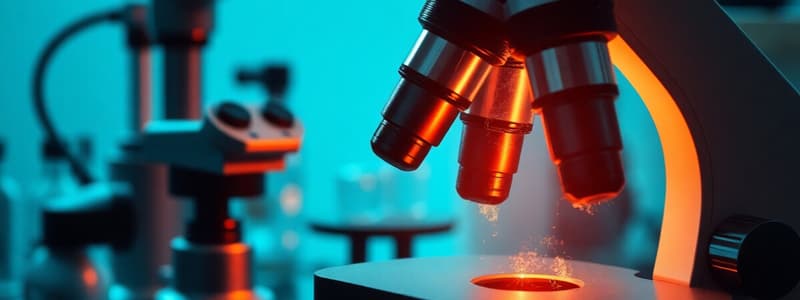Podcast
Questions and Answers
What does the term 'microscope' derive from?
What does the term 'microscope' derive from?
- Spanish roots meaning minute and watch
- French terms meaning tiny and observe
- Greek words meaning small and view (correct)
- Latin words meaning close and sight
Which component of the microscope is mainly used for initial focusing?
Which component of the microscope is mainly used for initial focusing?
- Nosepiece
- Fine adjustment knob
- Body tube
- Coarse adjustment knob (correct)
What is the total magnification if the eyepiece magnification is 10× and the objective lens magnification is 4×?
What is the total magnification if the eyepiece magnification is 10× and the objective lens magnification is 4×?
- 40× (correct)
- 24×
- 14×
- 100×
Which part of the microscope is responsible for holding the objectives?
Which part of the microscope is responsible for holding the objectives?
What is the function of the fine adjustment knob on a microscope?
What is the function of the fine adjustment knob on a microscope?
Which of the following is NOT part of the light microscope's components?
Which of the following is NOT part of the light microscope's components?
What type of lens is located closest to the specimen in a compound light microscope?
What type of lens is located closest to the specimen in a compound light microscope?
Which of the following statements about the light microscope is true?
Which of the following statements about the light microscope is true?
Flashcards
What is a microscope?
What is a microscope?
A microscope is an instrument that uses light and magnifying lenses to examine small objects invisible to the naked eye.
What are the two main types of lenses in a compound microscope?
What are the two main types of lenses in a compound microscope?
The lenses closest to your eye are called eyepieces, and the lenses closest to the object are called objective lenses.
How does the eyepiece affect the magnification?
How does the eyepiece affect the magnification?
The eyepiece magnifies the image from the objective lens, resulting in a total magnification.
What is the nosepiece?
What is the nosepiece?
Signup and view all the flashcards
What is the stage on a microscope?
What is the stage on a microscope?
Signup and view all the flashcards
What is the difference between the coarse and fine adjustment knobs?
What is the difference between the coarse and fine adjustment knobs?
Signup and view all the flashcards
What is the arm of a microscope?
What is the arm of a microscope?
Signup and view all the flashcards
What is the body tube?
What is the body tube?
Signup and view all the flashcards
Study Notes
Microscope Parts and Uses
- A microscope uses visible light and magnifying lenses to view small objects not visible to the naked eye.
- The word "microscope" combines "micro" (meaning small) and "scope" (meaning view).
- Light microscopes are commonly used in labs for diagnosing and studying microscopic organisms.
- A compound microscope uses multiple lenses to magnify an object.
- The eyepiece is the lens closest to the eye.
- The objective lens is the lens closest to the object being viewed.
- Total magnification is calculated by multiplying the magnification of the eyepiece and objective lens.
Microscope Components
- Eyepiece: Used to look through and see the specimen's image.
- Body Tube: A long tube connecting the eyepiece to the objectives.
- Nosepiece: Rotates to change the objective lens.
- Objective Lenses: Contain scanning (4X), low-power (10X), high-power (40X), and oil-immersion (100X) lenses used to magnify the specimen.
- Coarse Adjustment Knob: A large knob that moves the stage for initial focusing.
- Fine Adjustment Knob: A small knob that fine-tunes the focus.
- Stage: A flat surface where the specimen slide is placed to be viewed.
- Stage Clips: Holds the slide in place on the stage.
- Condenser: A part to collect, control, and concentrate light from the bulb onto the specimen.
- Diaphragm Control: Adjusts the amount of light passing through the condenser to the specimen.
- Light (Bulb): The light source; it makes the specimen easier to see.
- Arm: Supports the body tube and connects to the base.
- Base: The bottom of the microscope that supports the whole structure.
Magnification
- Total magnification = Magnification of Eyepiece × Magnification of Objective Lens
- Example: Eyepiece (10x), Objective (40x) = Total magnification (400x)
Microscope Applications
- Botanical field
- Biological field
- Crime investigation
- Educational field
- Medical field
Microscope Types
- Brightfield: The most common type, the specimen is darker than the surroundings and easier to see.
- Darkfield: The specimen appears brighter than the surroundings, useful for seeing transparent specimens.
Studying That Suits You
Use AI to generate personalized quizzes and flashcards to suit your learning preferences.



